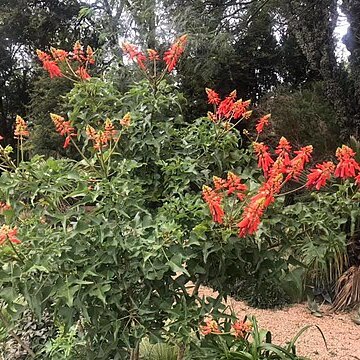Small shrub or tree, 0.5-3.0 m high; stem and branches ashen-grey with prickles; juvenile parts thinly pubescent. Leaves pinnately 3-foliate, widely ovate, gradually narrowing to acute apex. Stipules glandular, large variation in leaflet shape; petioles armed with prickles. Flowers deflexed at anthesis; appearing simultaneously with leaves; peduncle up to 500 mm. Calyx red; tube narrowly campanulate, subtruncate. Petals: keel segments partly fused abaxially. Stamens diadelphous. Flowering time summer. Pod 2-5-seeded, beaded with wide spaces between seeds; pod subligneous, sickle-shaped, blackish, smooth. Seeds scarlet; hilum oval, depressed, pale.
Leaflets 4.8–13.5 × 4.5–12.2 cm, ovate to broadly ovate, apiculate, often hastate with long apices, rarely narrowly oblong and acuminate, glabrous except when young; midvein and principal veins sparsely aculeate; petioles 2.5–13 cm long, usually armed with prickles; petiolules 3–5 mm long; stipules minute, caducous; stipels minute, glandular.
Inflorescence a terminal or axillary pseudoraceme, many-flowered; peduncle 7.7–28 cm long, glabrous; rhachis 5–13.5 cm long, glabrous; pedicels 2–6 mm long, ferruginous tomentose when young.
Corolla scarlet, glabrous; standard 2.4–4.8 × 1.6–2.4 cm, elliptic to obovate; wings 6–8 × 4–6 mm; keel 3–6 × 2–5 mm, the petals fused along their lower margins.
Calyx 5-lobed, ferruginous tomentose when young; tube 7–10 mm; lobes 1.5–3 mm long, narrowly to broadly triangular.
Suffrutex with woody rootstock, rarely a small tree to 4 m tall, stems armed with scattered prickles, to 8 mm long.
Vexillary stamen free almost to the base, others fused along two-thirds their length.
Pod black, 10–25 cm long, woody, moniliform, 4–11-seeded, 1–3 aborting.
Seeds red, 6–8 × 4–5 × 4–5 mm, reniform, with a black elliptic hilum.
Ovary 1–1.6 cm long, narrowly cylindrical, appressed hairy.


